Keywords
|
| Metamaterial Structure (MTMS), Rectangular Microstrip Patch Antenna, Return Loss, VSWR. |
INTRODUCTION
|
| There has been a lot of studies published on the improvement of performance of microstrip patch antenna and where metamaterial provides the improvement in desired characteristics without changing in resonant frequency. Paper published in 1986[1], the concept of a medium having both negative permittivity and permeability was theoretically given and predicted that electromagnetic plane waves in such a medium would have dramatically different characteristics. However there was not much progress until the year 1999. Then Prof. J.B.Pendry [2] proposed the design of thin wire structure that exhibits the negative value of permittivity and split ring resonator (SRR) exhibits the negative permeability. After that Dr.Smith [3] combined the two structures and also fabricated the first structure of metametarial. In fact many researches were done to increase the response of microstrip antenna as this type of antenna is desired for its low cost properties but compromises in gain and directivity. According to few studies done [4, 5] the LH MTM could actually increase the directivity. The plan metamaterial-based transmission line has attracted much attention [6,7] since it can be designed to have unusual characteristics (negative phase constant and so on) with abroad pass band and can also be easily constructed on PCBs. |
EQUATIONS FOR DESIGNING OF ANTENNA
|
| To design the patch antenna some parameters are necessary such as – resonant frequency, dielectric constant, substrate height. By using below mentioned formulas we are calculating the patch length, width, effective length, effective dielectric constant etc. |
| A. Width of Metallic Patch (W) |
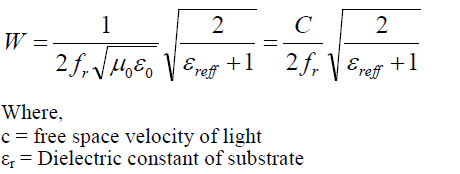 |
| The effective dielectric constant of the microstrip antenna to account for fringing field. Effective dielectric constant is calculated from: |
 |
DESIGN AND ANALYSIS OF MICROSTRIP PATCH ANTENNA NEW “E.” SHAPED METAMATERIAL STRUCTURE.
|
| The geometry of simple Rectangular Patch Antenna is shown in figure 1.The Antenna is planar Rectangular Patch Antenna fed by microstrip line on the PCB with dielectric constant (εr ) = 4.4, loss tangent (tan∂) = 0.01, and 1.6 mm of thickness (h).This Antenna is designed at frequency 2.684GHz. the essential parameters of Rectangular microstrip patch antenna are L= 26 mm W = 35 mm , Cut Width= 5mm , Cut Depth= 8mm, length of transmission line feed= 25 mm, with width of the feed= 3.009mm as shown in Figure 1. A research on MTMS was carried out to understand the fundamentals of the newly discovered substance. Then, IE3D Software was chosen to simulate the structure shown in Figure 4. |
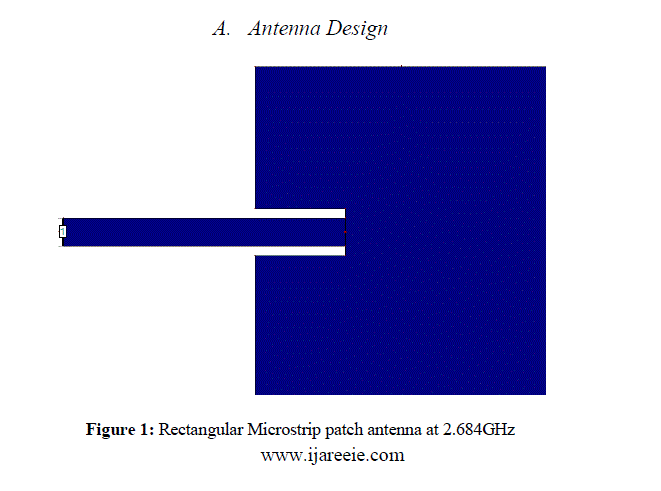 |
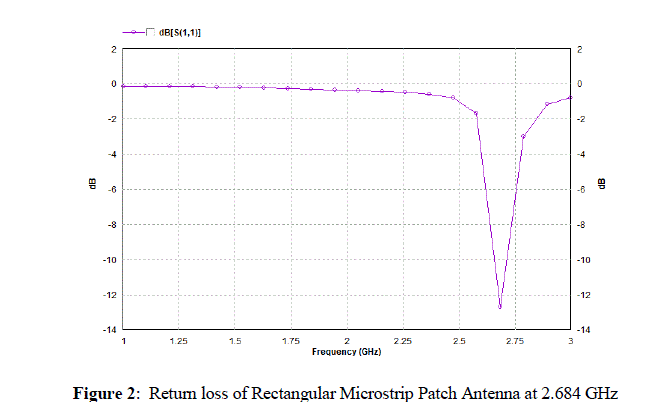 |
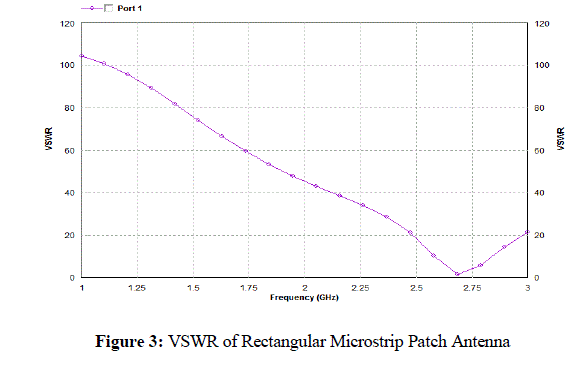 |
 |
| Here, |
| Cut width=7mm |
| Cut depth=15mm |
 |
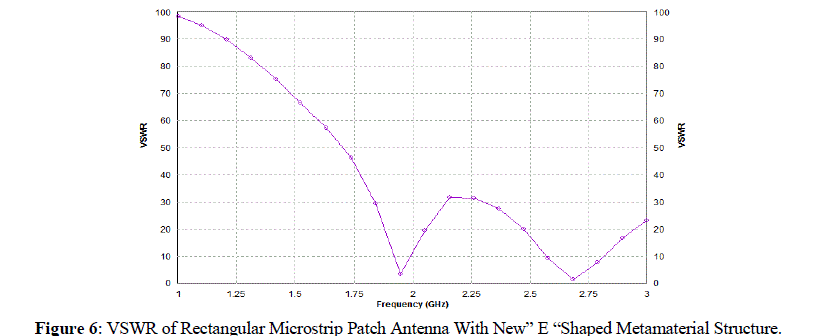 |
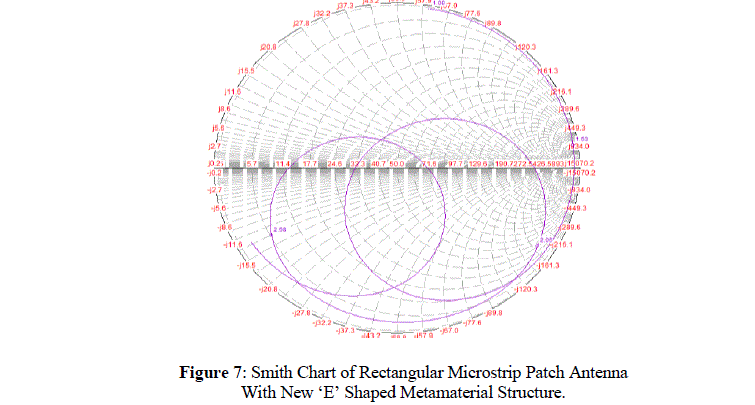 |
RESULT AND DISCUSSIONS
|
| After designing and simulating the Antenna, ensuring that it operates at the desired frequency and recording its Return Loss. The New „EâÃâ¬ÃŸ Shaped Metamaterial Structure is placed on the Rectangular Microstrip Patch Antenna at a height of 1.6 mm from ground plane. Subsequently, the simulation was done on varying distance between the MTMS and Patch Antenna to observe the gain of the Antenna. The Return Loss was also obtained at the same time and been analyzed. The simulated results of Rectangular Microstrip Patch Antenna with new „EâÃâ¬ÃŸ Shaped Metamaterial Structure are shown in figure 2 and 5 at 2.684GHz frequency simulation exhibits rectangular microstrip patch antenna alone shows the return loss of -12.68dB while when it is designed with metamaterial structure at 1.6mm it shows return loss of-17.72dB which shows significant reduction in return loss using such structure, that ultimately improve the quality of communication. Other supporting plots for various parameters like VSWR, Smith Chart, are shown here that shows the quality of simulated antenna using metamaterial structure is improving without making variations in other parameters. |
APPLICATIONS
|
| This antenna appear to be useful for wireless systems that continue to decrease in size, such as emergency communications devices, micro-sensors and portable ground-penetrating radars to search for tunnels, caverns and other geophysical features. Various metamaterial antenna systems can be employed to support surveillance sensors, communication links, navigation systems, and command and control systems. |
CONCLUSION
|
| In this paper, we have investigated the enhancement of the Rectangular Microstrip Patch Antenna performances using new „EâÃâ¬ÃŸ Shaped Metamaterial Structure. We have shown that left handed Metamaterial improves the gain as well as reduces return loss of this Patch Antenna. On making some variations in antenna parameters, gain can be improved up to desired limit but some practical limitation should be taken care while simulating the structure on IE3D Simulation Software. |
References
|
- D.M. Pozar, “A reciprocity method of analysis for printed slot and slot- coupled microstrip antennas,” IEEE Trans. Antennas and Propagation, vol. AP-34, pp. 1439-1446, Dec. 1986.
- J.B. Pendry, A.J. Holden, D.J. Robbins, W.J. Stewart, “magnetism from conductors and enhanced nonlinear phenomena” IEEE Trans. Micro Tech. vol.47 no.11, pp.2075-2081, Nov.1999.
- D.R. Smith, W.J. Padilla, D.C. Vier, et al, Composite medium with simultaneously negative permeability and permittivity, Phys Rev Lett 84 (2000), 4184–4187.
- Hu Jun, Yan Chun-sheng, Lin Qing-chun, New Patch Antenna with MTM Cover, J Zhejiang University SCIENCE A 7(1), 89-94, 2006.
- W. F. Richards, Y. T. Lo, and D. D. Harrison, , “An improved theory of microstrip antenna with applicationsâÃâ¬ÃŸÃ¢Ãâ¬ÃŸ, IEEE trans antenna and propagation, vol. AP-29, pp, 38-46, Jan. 1981.
- R.W. Ziolkowski , “ Design fabricating and fabrication and testing of double negative metamaterialsâÃâ¬ÃŸÃ¢Ãâ¬ÃŸ , IEEE transactions on antenna and propagation, vol.51, no.7, pp.1516-1529, july05.
- Yang, H.Y and N.G .Alexopoulos, gain enhancement method for printed circuit antenna through multiple superstates, IEEE transactions on antenna and propagation, vol-35, No-7, 860-863, jul. 1987.
|